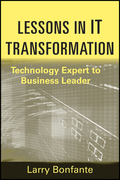
Lessons in IT transformation: technology expert to business leader
Bonfante, Larry
Important insights into the true purpose of IT—from a CIO's perspective Focusing on the qualities required to transform an organization through the lens ofthe CIO, this book provides practical advice on how to address key issues, aswell as create a context for the type of leadership qualities required to broaden the CIO's impact in every aspect of the corporation. Provides practical advice on key issues for leadership qualities Looks at the differences between leadership and management and the need for effectiveness in both disciplines Explores relationship management, communication skills, change management, developing human capital, sustainability, alignment, and qualities of great leaders A timely look at how the IT function can become totally aligned with the strategies and operational direction of the business enterprise, Lessons in IT Transformation reveals how CIOs can—and should—evolve from managers of utility services to business leaders who can drive revenue, value, and process redesign. INDICE: Preface. Introduction. Chapter 1: First Things FirstWhat is Leadership? Defining Leadership. Leadership versus Management. Three Questions. Communication Misconceptions About Leadership. The Role of a Leader. Chapter 2: That Vision Thing. Why is Vision Important? Whose Vision is it Anyway? Ownership. Creation of the Vision. Aligning Your Vision with the Vision of Your People.Inspiration. Making the Vision Real for People. Chapter 3: It's the Business Stupid! The Purpose of IT. The Foolishness of Alignment. Three (More!) Questions. Fiscal Management IT Is an Investment not a Cost. Driving Revenue. Engaging with the Board. The CIO as Business Leader not Technologist. Meaningful Metrics. Focus on What Matters. Managing Perception versus Reality. Chapter 4: Communication. The Importance of Communication. The Importance of Listening. Who Do I Need to Communicate With? How Should I Communicate with Them? Individual versus Group Communication. Should I Communicate Via Conversation, Presentation, or the Written Word? How Often Should I Communicate? Say What You Mean and Mean What You Say. The Need for Marketing. What is Your Brand? Leading a Volunteer Army. Communicating Tough Messages. Focusing on the Issue Not the Person.Honesty and Transparency. Chapter 5: Relationship Management. No Man (or Woman) is an Island. Focus on Helping Other People Succeed. Being a Team Builder. Building Credibility. The Law of WIFM What's in it for Me? But Enough About MeWhat do You Think About Me? Leaders Serve. When You Are a Leader it's Never About You!. What People Feel About You is More Important than Reality. Chapter 6: Developing Human Capital. Leading Persons. Leveraging People's Unique Talents. Engaging the Whole Person. Focusing on Strengths. Recruitment/Retention/Development. Making Sure a Person is Better Off for Having Had the Experience. Recognizing and Rewarding Your Peoples Efforts and Successes. Chapter 7: Leadingthe Process of Change. Change is Uncomfortable. Selling the Need for Change. Personalizing the Need for Change. Making Change a Part of Your Culture. Building Community. Ensuring Buy in. Breaking Change into Bite Sized Chunks. Supporting Progress Along the Way. Celebrating and Communicating Progress/Success. Change is the new Status Quo. Position versus Influence. Discipline of Project and Process Management. Process as Disabler. Developing a Culture of Innovation. Accountability. Leadership Begins with Me. Chapter 8: Partnering for Success. Some Words are Used Too Loosely. Developing a Partnership with Your Team. Developing a Culture of Empowerment. Creating a Team Oriented Environment. The 21st Century Workforce. Developing Partnerships with Your Clients. Partnering with Your Executive Management and Board of Directors. Sourcing Expanding YourTeam to Include Outside Partn
- ISBN: 978-1-1180-0447-0
- Editorial: John Wiley & Sons
- Encuadernacion: Cartoné
- Páginas: 208
- Fecha Publicación: 13/04/2011
- Nº Volúmenes: 1
- Idioma: Inglés
